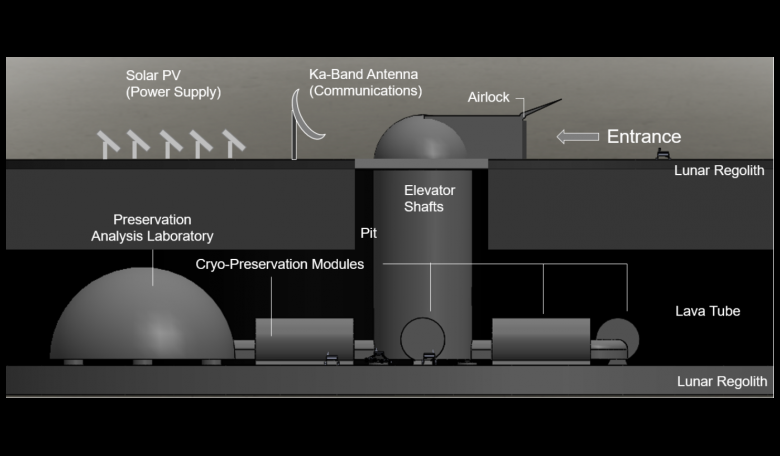Engineers at the University of Arizona are proposing an ambitious project to safeguard the future of millions of animal, plant and fungi species on Earth by cryogenically freezing seed, spore, sperm and egg samples in a lunar ark hidden in caves under the Moon’s surface.
Outlined over the weekend during the IEEE Aerospace Conference, the project, led by researcher Jekan Thanga takes inspiration from the biblical tale of Noah's Ark.
However, instead of rounding up two of every animal, Thanga and a group of his undergraduate and graduate students, suggest storing the necessary reproduction components of up to 6.7 million species in a underground facility on the Moon that is powered with solar panels on the surface.
This "modern global insurance policy”, would serve as a DNA repository that could help re-populate Earth should some species fail to adapt to a changing world-wide event such as global warming.
"Earth is naturally a volatile environment," said Thanga, a professor of aerospace and mechanical engineering in the UArizona College of Engineering. "As humans, we had a close call about 75,000 years ago with the Toba supervolcanic eruption, which caused a 1,000-year cooling period and, according to some, aligns with an estimated drop in human diversity. Because human civilisation has such a large footprint, if it were to collapse, that could have a negative cascading effect on the rest of the planet."
According to Thanga, the lunar ark concept, would be built in lava tubes that were discovered just beneath the moon's surface by scientists in 2013.
Formed by the crusting over of lava channels and pahoehoe flows, a network of around 200 such structures were identified, with some later theorised to be so huge, they could host planetary bases inside of them.
Aside from providing natural shelter from external elements, these voluminous tubes are also cold with temperatures averaging about minus 25 degrees Celsius (minus 15 degrees Fahrenheit).
But, to be cryopreserved, the seeds must be cooled beyond this to minus 180 celsius (minus 292 Fahrenheit) and the stem cells kept at minus 196 celsius (minus 320 Fahrenheit) say Thanga and team.
Super cooling equipment to extreme temperatures comes with its own risks, so the team suggest tapping into a phenomena called quantum levitation to mitigate risks of mechanical failure where metal is involved.
Quantum levitation relies on cryo-cooled superconductor material – or a material that transfers energy without losing any heat – floating above a powerful magnet. The two pieces are locked together at a fixed distance, so wherever the magnet goes, the superconductor follows.
"It's like they're locked in place by strings, but invisible strings," Thanga said. "When you get to cryogenic temperatures, strange things happen. Some of it just looks like magic but is based on tried and laboratory-tested physics principles at the edge of our understanding."
Quantum levitation could also be used to help miniature flying and hopping robots to enter the tubes and gather information about their layout, temperature and makeup. Called SphereX, this idea of an off-world robotic task force has already been proposed by Thanga and his group as a possible solution to help build the base.
Along with solar panels on the lunar surface to provide electricity to the cryogenic preservation modules and an elevator shaft to transport the samples and construction material down to the base of the lava tube, one of the biggest hurdles to overcome will be how to transport the goods to the Moon when the project is ready.
Based on some "quick, back-of-the-envelope calculations," Thanga said that although building a lunar ark is no small undertaking, it's not as overwhelming as it may sound.
“Transporting about 50 samples from each of 6.7 million species would require about 250 rocket launches. It took 40 rocket launches to build the International Space Station. It's not crazy big," Thanga said. "We were a little bit surprised about that."
Building an ark to preserve plant and animal life might seem far-fetched, but the idea has already implemented with success (on this planet at least) in the form of the Svalbard Seedbank; a structure in Norway that holds hundreds of thousands of seed samples to protect against accidental loss of biodiversity.
The team are confident however that with the right research such as investigating how the preserved seeds might be affected by a lack of gravity to how to construct and operate the ark and communicate with Earth, creating the ark can be done.
"What amazes me about projects like this is that they make me feel like we are getting closer to becoming a space civilisation, and to a not-very-distant future where humankind will have bases on the moon and Mars," said Álvaro Díaz-Flores Caminero, a UArizona doctoral student leading the thermal analysis for the project. "Multidisciplinary projects are hard due to their complexity, but I think the same complexity is what makes them beautiful."











